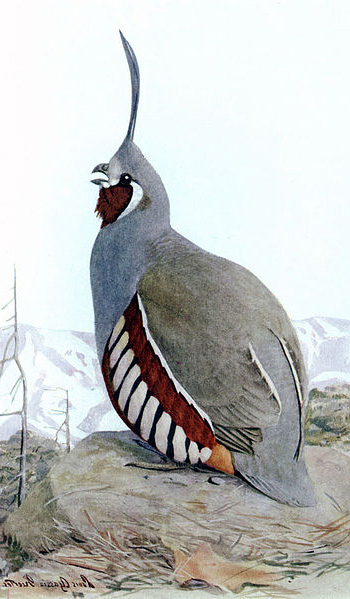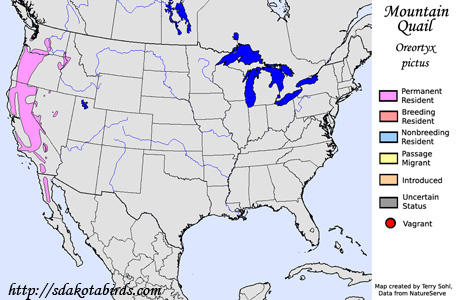| Length: 11 inches | Wingspan: 16 inches | Seasonality: Non-resident in South Dakota |
| ID Keys: Long straight plume on head, rufous-colored throat and sides, white bars on sides, gray and grayish-brown overall | ||
 Mountain
Quail are the largest of the quail species in North America, but given their
preference of thick brushy cover and tendency to hide or freeze when human
intruders approach, they are often less noticed than some of their more
well-known quail relatives like the
California Quail or Gambel's Quail.
They are found in mountainous areas of the far western United States.
Mountain
Quail are the largest of the quail species in North America, but given their
preference of thick brushy cover and tendency to hide or freeze when human
intruders approach, they are often less noticed than some of their more
well-known quail relatives like the
California Quail or Gambel's Quail.
They are found in mountainous areas of the far western United States.
Habitat: Found in montane forests with thick underbrush, in disturbed areas with shrubby secondary growth, and riparian thickets.
Diet: Feeds heavily on plant material, especially seeds, bulbs and tubers, leaves, acorns, berries, buds, and flowers. They will also sometimes feed on insects.
Behavior: Generally feeds on the ground or relatively close to the ground. They will scratch through leaves or dirt for food, make shallow digs for bulbs and tubers, or clamber through low shrubbery or other vegetation. Birds are gregarious outside of the breeding season, forming small coveys of 15-25 birds. As with other quail, they prefer to run rather than fly, with flight typically restricted to short bursts to escape danger.
Nesting: The nest is on the ground in very dense vegetative cover, usually next to the base of a shrub, a stump, a tree, or other object which provides cover. The nest is a simple depression on the ground lined with grass, plant down, leaves, and/or moss. Both parents help raise and defend the young.
Song: The male sings a very loud KEE-ar. Coveys with dispersed individuals often utter a loud clucking intended to reconstitute the covey.
Migration: Considered a permanent resident throughout most of its range. However, birds at higher elevations may move to lower elevations in winter.
Interactive eBird Map: Click here to access an interactive eBird map of Mountain Quail sightings
Similar Species: Similar in structure and some plumage characteristics to California Quail and Gambel's Quail.
Feeders: Mountain Quail will visit feeder setups with grain or seeds on the ground, primarily in suburban or rural areas with thick surrounding vegetative cover.
Conservation Status: Populations of Mountain Quail are considered stable in much of its range. The species is considered to be of "least concern" by the IUCN, and signifcant numbers are harvested by hunters in California and Oregon. However, Idaho populations have evidently disappeared, and there is evidence of decline in other parts of its northern range.
Further Information: 1) Cornell's All About Birds - Mountain Quail
2) California Partners in Flight - Mountain Quail
3) USGS Bird InfoCenter - Mountain Quail
Image Information: Watercolor painting from Game Birds of California - By Joseph Grinnell, Harold Bryant, and Tracey Storer, 1918 - University of California Semicentennial Publications - Public domain, copyright expired in the United States.
| Click below for a higher-resolution mapClick below for a higher-resolution map |
 |
| South Dakota Status: Non-resident in South Dakota |
Additional Mountain Quail Photos (coming soon!)
